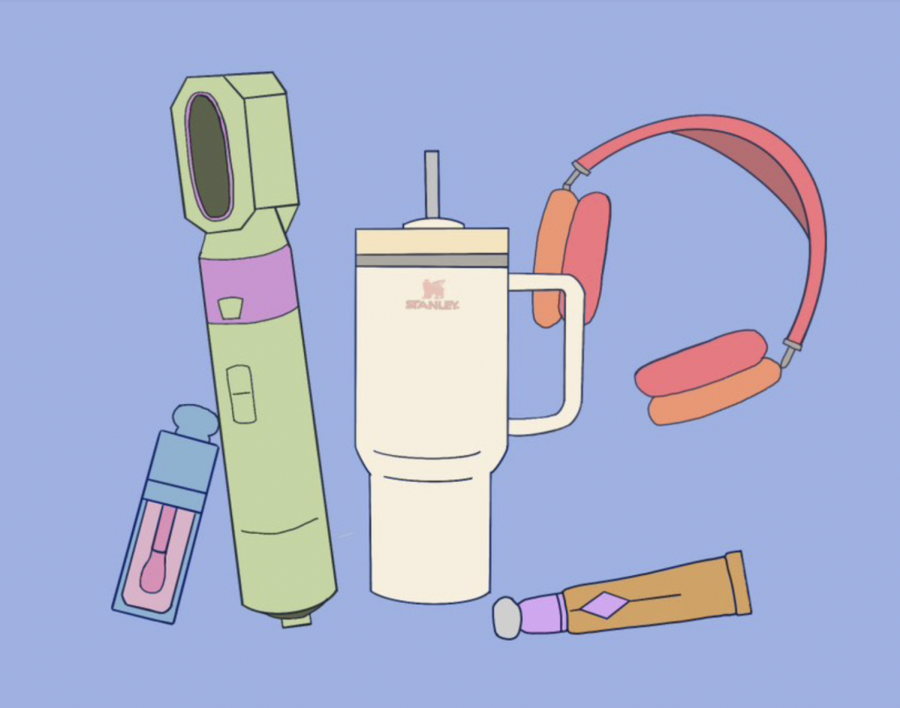De-influencing is becoming a new anti-trend on TikTok
Illustration by Safiye Demirci
The Dyson Airwrap hair styler, Stanley Cup, Dior Lip Oil, Charlotte Tilbury Contour Wand and Apple Airpod Max are some of the most popular items on tiktok for being criticized for their overcharged price. Many Tiktokers are sharing the alternatives to the infamous trendy products.
At a time when consumers are being influenced to buy a new, revolutionizing and anti-aging moisturizer, a magic airwrap hair styler, and another pair of UGGs in every corner of various social media platforms, a new de-influencing trend on TikTok blew up with more than 150 million videos under the hashtag #de-influencing.
Content creators on TikTok are discouraging their audience to buy trendy nonessential products like makeup and home goods and are suggesting more affordable “dupes” to promote wise shopping and give them more budget-friendly options. The platform is going through a wave of awareness about overconsumption and its detrimental effects on the environment.
Alexandra Boladian, a president of the Upcycling Club shared her opinion on the situation:

“When people shed light on unnecessary purchases or call out that they are not particularly sustainable for the environment or for your personal economic health, maybe people will start thinking differently and making better choices when it comes to their purchases.”
Various trends on TikTok have influenced people to buy another popular item causing overconsumption which led to pollution.
According to the Environmental Protection Agency, 15.1 million tons of textile waste partially caused by fast fashion was generated in 2013, of which 12.8 million tons were discarded. Many waterways are polluted with toxic dyes and microfiber. AP Macroeconomics teacher Clark Avery shares his views on overproduction from an economic standpoint.
“Things are becoming less expensive to produce, increasing money supply and most recently the backlog of spending has produced a trifecta of impact which has cost people to increase their consumption significantly.”
As Avery said above, some companies substitute materials for cheaper and sometimes not environment-friendly alternatives, for example using plastic instead of metal. Many products became less sustainable so consumers will have to replace them more frequently.
“Purchases like that are unsustainable economically for everyone, as well as the fact that people usually shop from these places because they’re trendy instead of looking into them first to make sure they are ethical,” Boladian shared.
Shein, a fast fashion online shop became a new marketplace for gen-z due to its popularity on TikTok and massive production of trendy items. Not that long ago the shop was claimed to be using unethical labor to produce cheap quality clothes, however, many customers are still loyal to the web store. Shein has approximately 74.7 million active shoppers of which 13.7 million are based in the US.
While current inflation appears to be a solution to overconsumption due to consumers’ reactions of avoiding impulsive purchases, inflation is not a long-term solution due to the economy favoring consumption, Avery explains.
According to the Bureau of Labor Statistics, wages and salaries increased by 1 percent, and benefit costs increased by 0.8 percent from Sept. 2022, while

total nonfarm payroll employment increased by 223,000 in December and the unemployment rate edged down to 3.5 percent.
More people are earning a stable income, which enables them to shop more frequently. But what steps should consumers take to ease the problem?
“First, we need to solve the problem of holding people accountable for the true cost of overconsumption,” Avery said.
In other words, everyone should be responsible and more considerate of the waste they produce through lavish shopping. However, holding everyone accountable is not realistic. This is how the de-influencing trend might become a new solution.
In her TikTok video, climate activist and sustainability scientist Aliana Wood stated that the influx of product boxes in recycling facilities was a sign of an influencer successfully swaying people to buy a new product. She witnessed how all the old products, most of which were still in perfect condition, were thrown into the landfill.
“That’s why I’m a fan of this de-influencing trend because it helps us create less waste and honestly helps you save money,” Wood stated.
The trend was created to make people rethink the necessity of the products and show affordable alternatives.
“I appreciate people who are stepping up, offering options,” noted Jocelyn South, Sage Creek’s ASB Accounting Technician. “Now people have something to purchase that is in their price range.”
It’s important to notice that the de-influencing trend is yet influential. Some content creators who participate in the movement are still promoting products, but in many cases, those alternatives are of the same quality as the high-end items and are reasonably priced.
Nonetheless, the trend became inclusive to all people with various income statuses. Many hope the movement will motivate people towards being sustainable and thoughtful of their next purchases.



Alex ◊ Mar 22, 2023 at 9:27 pm
damn daniel! this was a real lit read! cant wait for the next banger!